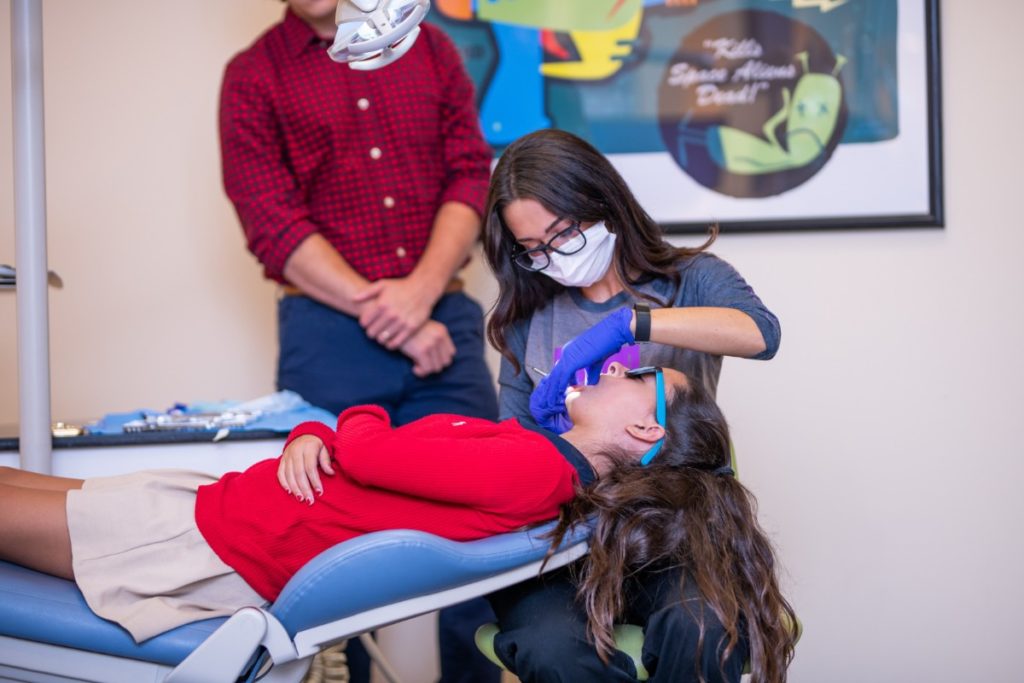Orthodontic treatment has gone through some major transformations in recent years, giving patients more choice than ever before when it comes to achieving a healthy, confident smile. Using state-of-the-art technology and innovative techniques, Dunn Orthodontics is able to successfully treat a wide range of orthodontic issues using different types of braces. These issues can include
- crowded teeth
- gaps between teeth
- protruding teeth
- overbite
- underbite
- crossbite
- impacted teeth
We do this using a variety of treatment methods, including traditional braces. These are the most common type of orthodontic treatment, and have seen a number of changes to their design, shape, size, and even color! Gone are the days of bulky brackets that stand out—today’s braces are smaller, more aesthetically pleasing, and can more efficiently move the teeth.
If you’ve been thinking about braces treatment to improve your oral health, you may be wondering what options you’ll have. Your initial appointment with Drs. Courtney and Matthew Dunn will consist of an orthodontic examination that will help them determine which treatment option is right for you, your smile, and your lifestyle.
Let’s take a look at the type of braces in Phoenix, AZ that are available, how they differ, and how we can use them to give you a beautiful smile you love!
A note about traditional braces
Braces are exceptionally good at fixing complex tooth issues, and can work faster at closing gaps and aligning teeth than other treatments might, which has the potential to shorten your treatment time. Because every case is different, treatment time with metal braces will vary from patient to patient. In general, however, the average tends to be anywhere from 14-24 months. Signs of improvement can often be seen in just a short period of time, which can be very encouraging!
The maintenance involved with traditional braces can sometimes be a little tricky in the beginning, but gets easier over time. A good dental hygiene routine is essential for oral health, particularly during orthodontic treatment. There are many accessories available that have been designed to make cleaning braces easier, such as water piks to help rinse any hard to reach areas and ortho picks to assist with flossing.
Some foods will need to be avoided while wearing braces in order to protect them, including anything sticky or crunchy since these can damage the brackets and wires. This won’t last forever, though, and will all be worth it once your braces come off and you see your beautiful new smile!
As a patient in traditional braces, you can expect follow-up visits with us every eight weeks or so throughout the treatment process. During these appointments, our Phoenix orthodontist will change the bands that are attached to the brackets, and the wire may be replaced as well. Check-ups tend to be pretty quick, and though there may be some slight residual soreness after each adjustment, it should only be temporary. These visits are a very important part of the overall treatment plan and will help us ensure the best results in the least amount of time, so try your best not to miss them.

Metal braces
Metal braces are one of the most recognizable symbols of orthodontics, and also the most common type of treatment. Thanks to a mix of stainless steel, nickel, and other high-quality metals, the brackets are very durable and long-lasting.
Modern metal braces are much more comfortable and lighter than they used to be, and they’re also customizable, thanks to a variety of fun colored bands to choose from! These braces deliver excellent results, and are especially useful in cases that are more severe or complicated.
Since they don’t require some of the more complex technology or expensive equipment that newer treatments do, metal braces also tend to be a slightly more affordable option. The overall strength, durability, and cost-effectiveness of traditional braces keep them the top treatment for orthodontics, year after year.
Ceramic braces
Sometimes these are referred to as clear braces, tooth-colored braces, or esthetic braces. Ceramic braces function in much the same way metal braces do. They have the added benefit of semi-translucent or tooth-colored ceramic brackets. Ceramic braces are about the same size and shape as metal braces. They’re better able to blend in with a patient’s natural smile for a more subtle straightening option like lingual braces.
Although ceramic braces are tough, the material they are made from can be prone to chipping or cracking. Since metal braces can tolerate more pressure than ceramic ones, they may be a better option for those who have severe corrections that need to be made.
Ceramic brackets are often slightly more costly than metal brackets, as well. They are also more prone to breakage. Many believe ceramic braces are generally better suited to adults and older teens. That said, ceramic braces can be an excellent option for many patients. When paired with clear, white, or tooth-colored wires and elastic ties, they are an incredibly discreet and efficient way to straighten smiles!
Damon braces
Damon system braces are self-ligating, meaning they use a slide mechanism to hold the archwire. Some believe this reduces the amount of pressure exerted on the teeth and allows the teeth to move more freely, quickly, and comfortably. While unproven, this innovative treatment option claims several features, including:
- freedom of movement, which results in faster treatment times with gentler forces
- precision and effectiveness, reducing the need for many of the more time-consuming
- procedures used with traditional braces
- fewer adjustments required
- less discomfort than traditional braces
- smaller, more comfortable braces that are also easier to keep clean
Damon braces eliminate the need for elastic or metal “ties”. They use a specialized clip to help the archwire guide the teeth into place. Some believe these clips reduce the amount of pressure being placed on the tooth. Some believe they require fewer adjustments since there are no elastics to replace. Using gentle, low-friction force might mean less discomfort. It’s more likely that he titanium wires that are used are very light. This provides maximum comfort as they gently guide teeth into the desired positions.
As with traditional metal braces, treatment time will vary from case to case. It does not tend to be any faster than conventional braces. The same number of appointments are required during treatment as well, making your Damon experience with us convenient and hassle-free. Damon braces are designed to be discreet, comfortable, and easy to keep clean. Damon braces are also available in clear brackets for patients who want a smile that doesn’t sacrifice aesthetics!
Braces to work with every smile at Dunn Orthodontics
Not every smile is equal and what will work for one patient may not be a good choice for another. That’s why Dunn Orthodontics creates a personalized treatment plan for every patient! Our doctors have the education, skills, and experience to recommend the course of treatment that’s best for your unique smile.
If you’re in Phoenix, Scottsdale, or Litchfield Park, we’d love to meet you. We can talk more about how braces can give you a confident smile you love! Get in touch today to schedule your FREE consultation.
 Free Consultation
Free Consultation

